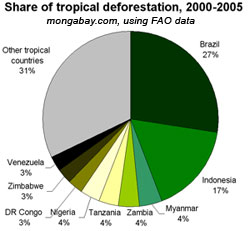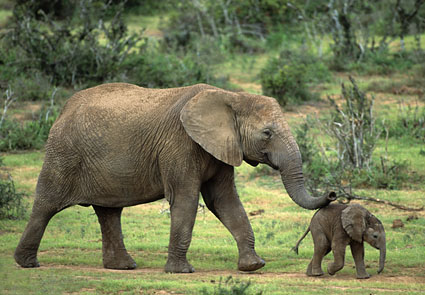What are tropical forests?
Tropical forests are usually situated at or close to the equator. The term tropical forests encompasses not just the well known dense rain forests, but also drier more season forests on the edges of rain forests. These diverse ecosystems only cover 7% of the Earth's surface, but account for an astonishing 50% of all species recorded.
 (Source: http://earthobservatory.nasa.gov/Features/Deforestation/Images/biodiversity.gif)
(Source: http://earthobservatory.nasa.gov/Features/Deforestation/Images/biodiversity.gif)Just this statistic alone should be enough to stop all deforestation, but sadly it continues to this day. And what is even more disturbing is that these forests offer even more then biodiversity as you will learn below.
Where is this happening?
Even though deforestation occurs in almost all countries that claim a tropical forest the worst has occurred in Latin American and in Southeast Asia as one can see from the pie chart below. As much as 40% of forests in these regions have been destroyed and that number is increasing.
(Source: http://photos.mongabay.com/07/trop_defor_pie-250.jpg)
What is the negative impact of this destruction on the environment?
A single tree. In the mind of most individuals one tree does not have immense value. How could it? It's just a single tree. This view is wrong, completely and utterly wrong. When we cut down a tree in a tropical rain forest we demolish the home of thousands of living organisms. This single event has a ripple effect that impacts all the other organisms in the ecosystem. The more and more trees we destroy the worse and worse impact we have on the environment. Species can become endangered and sometimes extinct through tropical deforestation.
Another debilitating effect of tropical deforestation is that it leads to soil erosion. When trees are cut down the suns rays come into contact with the soil and dry it out. The soil then loses its nutrients and then get washed away since there are no roots to hold it in place. Not only does this destroy the landscape, but it prevents trees from being replanted as the soil is permanently infertile.
Another terrible impact that deforestation has on the environment is that it disturbs the water cycle and ultimately can result in climate change. Trees take water in through their roots and later this water is released into the air as water vapor. When trees are cut down they can no longer transpire water into the atmosphere which can affect rainfall throughout the region.
The final effect of tropical deforestation is the simple fact of trees importance in the process of photosynthesis. When mass amounts of trees are destroyed they can no longer take in carbon dioxide, so more of it builds up in the atmosphere. This leads to an increase in global temperature.
What is the negative impact of this destruction on society?The numbers may be daunting, but if enough people are informed change can happen and the increasing rates of tropical deforestation can be slowed to a halt.
What is the negative impact of this destruction on the environment?
A single tree. In the mind of most individuals one tree does not have immense value. How could it? It's just a single tree. This view is wrong, completely and utterly wrong. When we cut down a tree in a tropical rain forest we demolish the home of thousands of living organisms. This single event has a ripple effect that impacts all the other organisms in the ecosystem. The more and more trees we destroy the worse and worse impact we have on the environment. Species can become endangered and sometimes extinct through tropical deforestation.
(Source: http://www.mommynature.com/images/Kapok%20tree%201.jpg)
Another debilitating effect of tropical deforestation is that it leads to soil erosion. When trees are cut down the suns rays come into contact with the soil and dry it out. The soil then loses its nutrients and then get washed away since there are no roots to hold it in place. Not only does this destroy the landscape, but it prevents trees from being replanted as the soil is permanently infertile.
(Source: http://www.globaleye.org.uk/secondary_spring01/eyeon/images/soil_erosion.jpg)
Another terrible impact that deforestation has on the environment is that it disturbs the water cycle and ultimately can result in climate change. Trees take water in through their roots and later this water is released into the air as water vapor. When trees are cut down they can no longer transpire water into the atmosphere which can affect rainfall throughout the region.
(Source: http://www.whentechfails.com/files/graphics/fig_5.png)
The final effect of tropical deforestation is the simple fact of trees importance in the process of photosynthesis. When mass amounts of trees are destroyed they can no longer take in carbon dioxide, so more of it builds up in the atmosphere. This leads to an increase in global temperature.
Most people who take deforestation for granted simply do not understand the scope and scale of these magnificent natural wonders and how much they mean to the world. We focus too much on our needs then the worlds needs. Companies only look at trees as sources of wood to make products. They do not see the bigger picture. The bigger picture is simply seen in the devastating effects of deforestation. A tropical forest is full of undiscovered species that can lead to the discovery and creation of world changing medicines. Who knows? If we destroy these forests we may never find the cures for life threatening diseases such as cancer.
(Source: http://s.ngeo.com/wpf/media-live/photos/000/203/cache/foja-mountains-new-species-discovered-fieldwork_20351_600x450.jpg)
Other negative impacts include the threat to the human race as a whole with global warming and also an affect on rainfall which can negatively impact farms who rely on rain in the United States. These tropical forests are so crucial yet we continue to cut them down. Tropical deforestation must be stopped.
How is this happening and what can be done to prevent it?
Tropical deforestation occurs for many different reasons. The main reason is the resource wood. Wood has many uses such as paper, furniture, and lumber for houses. Companies go into these forests to harvest the wood and in doing so destroy the forests. Another explanation is the growth of the countries who claim the forests. Their expanding economies and populations require more land for buildings and houses. Sadly, in order to make this room forests are being cleared.
(Source: http://gotreefree.com.au/wp-content/uploads/2009/06/illegal-deforestation-and-land.jpg)
Although preventing deforestation requires a global effort, there are still several ways in which you as an individual can make a difference. By simply planting a tree, you are adding more life to the environment. Also, use recycled papers and purchase products that do not harm the tropical forest. Another great way to help out is by spreading the word and being an activist. For example, write letters to politicians, donate money to aid organizations, or just talk to friends and family about tropical deforestation.
Hopefully you have taken a lot away from this public service announcement and now understand the tropical forest and why deforestation must be stopped.
 Subscribe
Subscribe





















